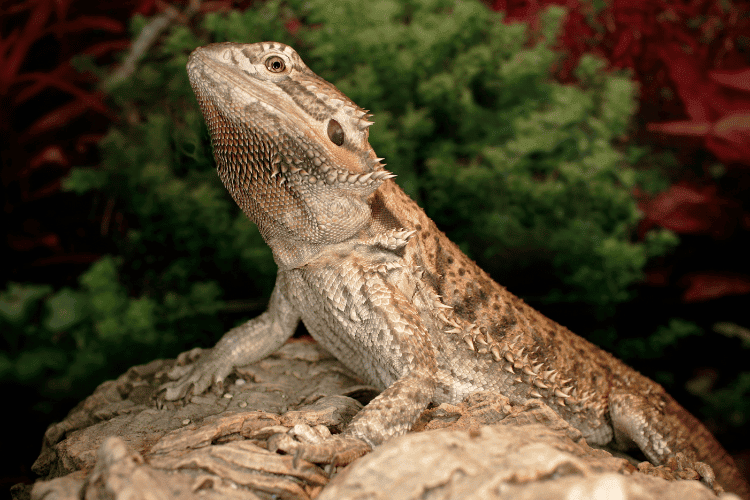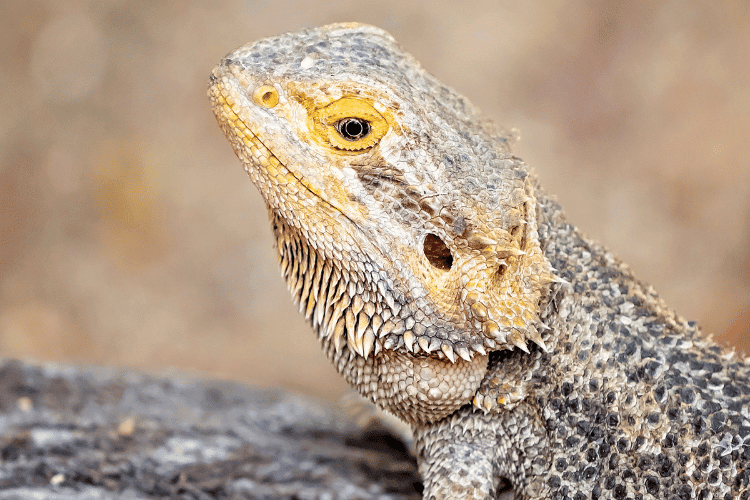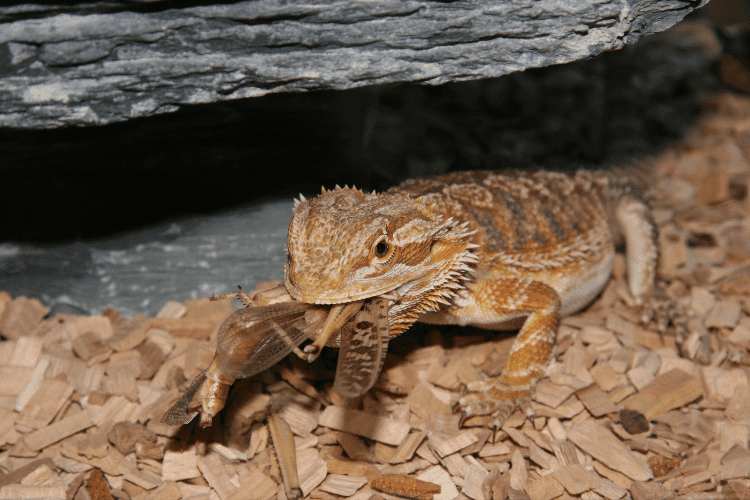
Black spots on bearded dragons are a common occurrence. They can be caused by a variety of factors, including natural coloration, dirt or debris, abrasions or burns, fungal infection, parasite infestation, and scale rot.
In this article, we will discuss the causes of black spots on your pet lizard bearded dragons, what to do if you see them, and how to prevent them.
Ask the Expert
Let’s start with our veterinary expert Dr Jerry, who answers some of the most common questions about black spots.
Ask The Expert

What causes black spots on a bearded dragon?
Every beardie lover might have encountered black spots on their bearded dragon at some point. Usually, this is not a cause for alarm but it’s cautionary to know what could lead to these spots. Reasons why a bearded dragon would have black spots especially under its belly, around the limbs or beards could range from a simple color pattern, pigmentation, dirt to infection. Most times, black spots seen on beardies could be attributed to stress. If your pet has been recently moved to a new location or is under an unfavorable condition, it could lead to development of black spots. A black spot could also be infected if the black spot was due to an abrasion or injury left untreated which could lead to secondary bacterial infection. One should be worried and call the attention of a Vet if the beardie keeps itching at that spot.
Bearded dragon black fungus treatment
If a black spot on your beardie causes irritation and discomfort, it could be a symptom of a fungal infection. This spot could lead to other forms of conditions and even get larger if left untreated. The first point of action to treating a fungal infection is to remove all factors that could put your beardie at risk of getting worse. Clean out its tank and regulate the tank’s humidity and temperature properly. Secondly, visit a Vet for a routine checkup and a proper diagnosis. If your beardie is diagnosed with a fungal infection, the Vet would treat it with antibiotics such as terbinafine and would recommend other topical antifungal medication you could use at home. It could take a while for your beardie to recover from a fungal infection. During this period, boost its hygiene, maintain the right tank conditions, provide a balanced diet and prevent it from coming in contact with other beardies.
Bearded dragon stress marks vs normal black spots
Stress marks and black spots on a bearded dragon pretty much look alike. While black spots appear as they sound, stress marks could be in the form of stripes or markings with an oval shape on the body of your bearded dragon. Stress marks are most times temporary which goes away as soon as the stress factors are removed. While black spots could last longer depending on the causative factor. If a black spot is as a result of pigmentation or infection, it could last longer than a stress mark. It could be sometimes confusing to differentiate between the two since they could co-exist on your beardie. While a stress is not life threatening, a black spot could be if it’s as a result of an infection.
Black spots on bearded dragon neck and shoulders
It is quite normal to have black spot like pattern on your bearded dragon’s neck and shoulder. This may be due to pigmentation and colour patterns which show up over time. You would notice a pattern of dark spots on either sides of its neck and just on top of the shoulder. The spots could extend to its face which could be due to darkening of the scales. During shedding, remnant scales may become infected and lead to scale rot which presents as dark spots. Your beardie may require medical attention if it shows other symptoms like lethargy and lack of appetite.
Why does my bearded dragon have black spots on his belly and stomach
Bearded dragons could have black spots on their belly for numerous reasons such as stress and environmental conditions. Those black spots could also be as a result of bruises from the substrate. Always use the most comfortable substrate for your beardie to avoid abrasions. These spots could also darken when the beardie absorbs so much heat and lightens up when it repels heat. The black spots could indicate when your beardie is stressed or uncomfortable but most times it is normal to have them.
Black spots on bearded dragon tail
These spots if not normal should be differentiated from tail rot- a condition in bearded dragons where the tip of the tail turns black due to tissue death called necrosis. This often happens after the beardie must have sustained an injury during a fight or while in the tank which later got infected. Also, poor hygiene and wrong tank setup could result in this. During shedding, the tail could undergo incomplete shedding and remnants of the scales could restrict blood flow and cause a tail rot which looks like black spots. To help your bearded dragon overcome this problem, maintain proper tank setup and good hygiene within the tank, also remove every object that could inflict harm on your beardie. If the condition persists, take it to a Vet for proper examination and treatment with antibiotics.
Dr. Jerry is the lead Veterinary manager at Ectovis, supervising clinical and non-clinical activities to provide a better pet health service to pet owners and their pets.
He has spent half a decade developing systems, recommending and reviewing pet products. As a Veterinarian and a product review expert, Jerry has helped 100s of pets gain better health status, putting a smile on the faces of many pet owners.
Aside from working in the veterinary space, Jerry also has a flare for writing, and analyzing data.
Dr. Jerry Ayaebi (DVM, CEP) received a DVM degree for the University of Nigeria, Nsukka. He has also attained some certification in data analysis and design.
Follow him on Linkedin here
Causes of Black Spots on Bearded Dragons
It's important to note that not all black spots on bearded dragons are cause for concern. Some are simply part of the dragon's natural coloration or markings. The base color of a bearded dragon is often mottled, and there are sometimes color morphs with different darker spots.
However, if you see a new dark spot growing, or changing in appearance, it's best to take your pet reptiles to the vet.
1. Natural Coloration or Markings
Some bearded dragons have natural black spots on their skin as part of their coloration. These spots are usually small and evenly distributed throughout the body. They aren't harmful and don't require any treatment.
2. Dirt or Debris
Black spots on bearded dragons may be caused by dirt or debris that has become stuck to the scales. These spots can usually be removed by gently washing your bearded dragon with a mild soap and water solution.
3. Abrasions or Burns
Black spots can also be caused by abrasions or burns. If your bearded dragon has been injured, the spots may be accompanied by other symptoms, such as swelling, pain, or bleeding. If you suspect that your bearded dragon has been injured, you should take it to the vet for treatment.
4. Fungal Infection
Another possible cause of black spots on bearded dragons is a fungal infection. Fungal infections can cause black, velvety patches on the skin. If you suspect that your bearded dragon has a fungal infection, you should take it to the vet for diagnosis and treatment.
5. Parasite Infestation
Parasite infestation can also cause black spots on bearded dragons. Parasites such as mites and ticks can cause black spots on the skin of bearded dragons. If you suspect that your bearded dragon has a parasite infestation, you should take it to the vet for diagnosis and veterinary treatment.
6. Scale Rot
Scale rot is a condition that can cause black spots on the skin of bearded dragons. Excessive moisture on the skin is the usual culprit behind scale rot. For example, if your bearded dragon's enclosure is too humid, it may develop scale rot.
Symptoms of scale rot include black, crusty scales, swelling, and pain. If you suspect that your bearded dragon has scale rot, you should take it to the vet for medical attention.
7. Stress Marks on Bearded Dragons
Stress marks in bearded dragons are dark lines or spots that appear on their skin when they're feeling stressed or threatened.
Bearded dragon stress marks are caused by the dilation of the blood vessels in the skin, which allows more blood to flow to the surface. This makes the skin appear darker. Stress marks can be found anywhere on the body, but they're most commonly seen on the belly, sides, and legs.
In some cases, stress marks can cause black spots to appear on the skin. This is because the increased blood flow can cause melanin, the pigment that gives skin its color, to be deposited in small clusters. These clusters of melanin appear as black spots.

There are a number of things that can cause stress in bearded dragons, including:
- Changes in their environment: This could include incorrect temperature, changes in humidity or incorrect humidity levels, lighting or UV light levels, or the presence of other animals.
- Prolonged handling: Bearded dragons can become stressed if they are handled for too long or too frequently.
- Boredom: Bearded dragons need plenty of enrichment to keep them from getting bored. Bored bearded dragons may become stressed and even exhibit a clear lack of appetite.
- Medical problems: Bearded dragons can also become stressed if they are not feeling well as a result of various health issues.
8. Tail rot
Tail rot can happen when there is an injury to the tail and the healthy tissues become infected. This can cause black spotting, usually starting with the end of the tail. Eventually this will cause the whole tail to turn black, and you should definitely see a vet if you suspect there is tail rot.
What to Do if You See Black Spots on Your Bearded Dragon
If you see black spots on your bearded dragon, the first thing you should do is monitor them closely. Remember, some beardies have spots as part of their natural color pattern, so it is important to check the spots regularly to see if they're changing in size, color, or shape.
If the spots are small and do not change, you can probably just keep an eye on them. However, if the spots are large, growing, or changing color, you should take your bearded dragon to the vet.
You should also watch out for any signs of stress, common diseases, skin infection, respiratory tract infections, or any issues related to the shedding process. If you see any sign of infection, then you need to see a vet as soon as possible.
1. Monitor the Spots
It's important to monitor the spots for a couple of days because some of the causes of black spots on bearded dragons can be serious.
For example, if the spots are caused by a fungal infection, they can spread and cause the dragon to become ill. However if scale rot is behind the black spots then the dragon's skin can become infected and the infection can spread to the underlying tissue which again can be very serious.
2. Identify the Cause
Once you have monitored the spots for a while, you should try to identify the cause. This can be a bit tricky so here are a few things to look out for.
For example:
- If the spots are caused by dirt or debris, you may be able to see the offending material on the dragon's skin.
- If the spots are caused by an injury, you may see signs of trauma, such as swelling or bleeding.
- If the spots are caused by fungal growth or bacterial infection, you may see a velvety or fuzzy appearance to the skin.
- If the spots are caused by parasitic infections, you may see tiny white or black dots on the skin.
- If you are unable to identify the cause of the black spots on your own, you should take your bearded dragon to the vet.
The vet will be able to perform a physical examination and diagnostic tests to determine the cause of the spots.
3. Take your Bearded Dragon to the Vet
If you're unable to identify the cause of the black spots, or if the spots are large, growing, or changing color, you should take your bearded dragon to the vet. The vet will be able to diagnose the cause of the black spots and recommend the best course of treatment, whether that's a course of antibiotics, antifungal medication, or parasite treatment.
They may also recommend that you make changes to your bearded dragon's enclosure or diet.
4. Keep Your Bearded Dragon's Enclosure Clean and Dry
One of the best ways to prevent black spots on bearded dragons is to keep their enclosure clean and dry.
This means changing the substrate regularly and cleaning the
Additionally, provide your pet with a hiding spot where it can lower its body temperature. The proper ambient temperature should be around 95-100 Degrees. These measures should minimize the risk of infections. Check for any external heat sources, such as a radiator or electric device that could be causing extra heat. It is important the enclosure is at the proper temperature to avoid stress.
5. Provide Your Bearded Dragon With a Varied Diet
Another way to prevent black spots on bearded dragons is to provide them with a varied balanced diet.
This means feeding them a variety of fruits, vegetables, and insects. A varied diet will help to keep your bearded dragon healthy and strong, which will make them less susceptible to infections and other health problems.
6. Monitor Your Bearded Dragon's Behavior For Any Changes
In addition to monitoring the black spots on your bearded dragon, you should also monitor their behavior for any changes.
If your bearded dragon is acting lethargic, refusing to eat, or losing weight, this could be a sign of a serious health problem. If you notice any of these changes, you should take your bearded dragon to the vet immediately.
Treatment for Black Spots on Bearded Dragons
It's important to note that the treatment and healing process for black spots on bearded dragons will vary depending on the cause. If you're unsure of the cause of the black spots, you should take your bearded dragon to the vet for diagnosis and treatment.

1. Treatment for Natural Black Spots
Black spots that are part of the bearded dragon's natural coloration don't require any treatment. These spots are usually small and evenly distributed throughout the body.
2. Treatment for Dirt or Debris
When dirt or debris are the cause of the black spots, you can simply remove the offending material by gently washing your bearded dragon with a mild soap and fresh water solution. Be sure to rinse the soap off thoroughly to avoid any skin irritation.
3. Treatment for Abrasions or Burns
If the black spots are caused by abrasions or burns, you may need to apply a topical antibiotic to prevent infection. You can use a topical antibiotic cream or ointment that is designed for use on reptiles. You could even use a betadine solution, but check with the vet first.
4. Treatment for Fungal Infection
For black spots caused by a fungal infection, you will need to apply an antifungal cream or ointment. You can find antifungal cream or ointment designed specifically for use on reptiles. In more severe cases, your vet may prescribe oral antifungal medication.
5. Treatment for Parasite Infestation
Your bearded dragon needs anti parasite infection medication if the black spots are caused by a parasite infestation. The type of medication that your vet prescribes will depend on the type of parasite that is causing the infection.
6. Treatment for Scale Rot
If the black spots are caused by scale rot, clean the affected area and apply a topical antibiotic. You can use a topical antibiotic cream or ointment that is designed for use on reptiles. In more severe cases, your vet may need to remove the affected scales.
Conclusion
Black spots on bearded dragons can be a cause for concern, but they are not always a sign of a serious health problem.
In most cases, black spots on bearded dragons are harmless and do not require any treatment. However, there are some causes of black spots that can be serious, such as fungal infection and scale rot.
If you see black spots on your bearded dragon that are large, growing, or changing color, it‘s important to take your dragon to the vet right away.



